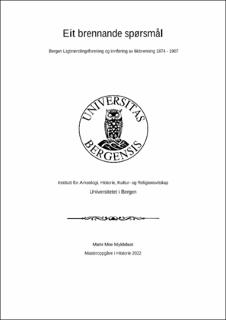| dc.contributor.author | Myklebust, Marie Moe | |
| dc.date.accessioned | 2023-01-24T03:16:55Z | |
| dc.date.available | 2023-01-24T03:16:55Z | |
| dc.date.issued | 2022-11-21 | |
| dc.date.submitted | 2023-01-23T09:28:21Z | |
| dc.identifier.uri | https://hdl.handle.net/11250/3045534 | |
| dc.description.abstract | I dag kan ein fritt velje mellom kremasjon og jordgravlegging, men for ca. 125 år sidan var kremasjon, då kalla ligbrænding, ulovleg i Noreg. Før dette hadde likbrenning vore ulovleg i nesten 1000 år. Denne oppgåva spør kvifor likbrenning kom tilbake, og kva betydning dette hadde. Desse spørsmåla vert undersøkt gjennom to perspektiv: Det lange historiske perspektivet til historikarar i ettertida, og det korte historiske perspektivet til aktørane i samtida. Det lange historiske perspektivet vert drøfta gjennom to forfattarar og deira verk: Philippe Ariès og Døden i Vesten, og Thomas W. Laqueur og The work of the dead. Dei har begge ulike måtar å forstå dødshistorie på, og forklarar dermed gjeninnføringa av likbrenning ulikt. Det korte historiske perspektivet vert drøfta gjennom Bergens Ligbrændingsforening. Denne foreininga var med på arbeidet for å gjere likbrenning lovleg i Noreg, i tillegg til at den fekk oppført Noreg sitt første krematorium på Møllendal i 1907. Argumenta for og imot likbrenning, arbeidet til foreininga, og personane som var involvert, gir eit bilete av likbrenningsrørsla i Bergen på siste del av 1800-talet. | |
| dc.description.abstract | This thesis aims to explore why cremation came back in the late 1800’s, and how it has been attributed meaning. It does so by looking at two different historical perspectives: The long historical perspective taken by historians, and the short historical perspective of the historical actors. The long perspective is shown through Phillippe Ariès and the History of mentalities, contrasted by Thomas W. Laqueur and the New Cultural History. The short perspective is explored through the Cremation Society in Bergen. By discussing the ways Ariès and Laqueur has written the history of death over the last 1000 years, I could illustrate the difference in how historians choose to interpret and give meaning to changes in how we view and treat the dead. Ariès explains the changes in death history as a result of changes in attitudes. He explains cremation as the most extreme example of a society trying to forget and hide the dead. Laqueur explains that cremation came back, not because of new attitudes or needs, but because it could be used to mobilize the dead in other unrelated projects. Laqueur’s use of anthropology leads him to find continuity in how the living view and attribute meaning to the dead, and that cremation did not change or disturb this fact. The local cremation society in Bergen formed in 1892, before cremation became legal in 1898, and Bergen constructed Norway’s first crematorium in 1907. Through analysing documents and newspapers, I have found which arguments were used for and against cremation, and who championed the case. The argument of hygiene and lack of space was often used, even though it was not very relevant in Bergen. Since the neighbouring countries already had introduced cremation, the argument of modernization, progress and the right to choose was also emphasized. One finding shows how the society included people from heavily differing political and religious beliefs. The people who were against cremation warned that it would threaten society and the established traditions, while the people who were pro-cremation emphasized how cremation could help the living and create progress without disturbing the ritual and ceremonial traditions. The question of how we treat and handle the dead is still relevant today. The combination of how different historians explain the return of cremation and its meaning, and the reactions and arguments of the historical actors gives great insight to the cremation movement of the late 1800’s. | |
| dc.language.iso | nno | |
| dc.publisher | The University of Bergen | |
| dc.rights | Copyright the Author. All rights reserved | |
| dc.subject | likbrenning | |
| dc.subject | bergens ligbrændingsforening | |
| dc.subject | Bergens likbrenningsforening | |
| dc.subject | ligbrænding | |
| dc.subject | kremasjon | |
| dc.subject | dødshistorie | |
| dc.subject | Thomas Laqueur | |
| dc.subject | ligbrændingsforening | |
| dc.subject | Philippe Ariès | |
| dc.subject | Bergen | |
| dc.subject | død | |
| dc.subject | Schak Bull | |
| dc.title | Eit brennande spørsmål - Bergen Ligbrændingsforening og innføring av likbrenning 1874 - 1907 | |
| dc.title.alternative | A burning question - The cremation Society in Bergen and the introduction of modern cremation 1874 – 1907 | |
| dc.type | Master thesis | |
| dc.date.updated | 2023-01-23T09:28:21Z | |
| dc.rights.holder | Copyright the Author. All rights reserved | |
| dc.description.degree | Historie mastergradsoppgåve | |
| dc.description.localcode | HIS350 | |
| dc.description.localcode | MAHF-HIS | |
| dc.description.localcode | MAHF-LÆHR | |
| dc.subject.nus | 713107 | |
| fs.subjectcode | HIS350 | |
| fs.unitcode | 11-22-0 | |
